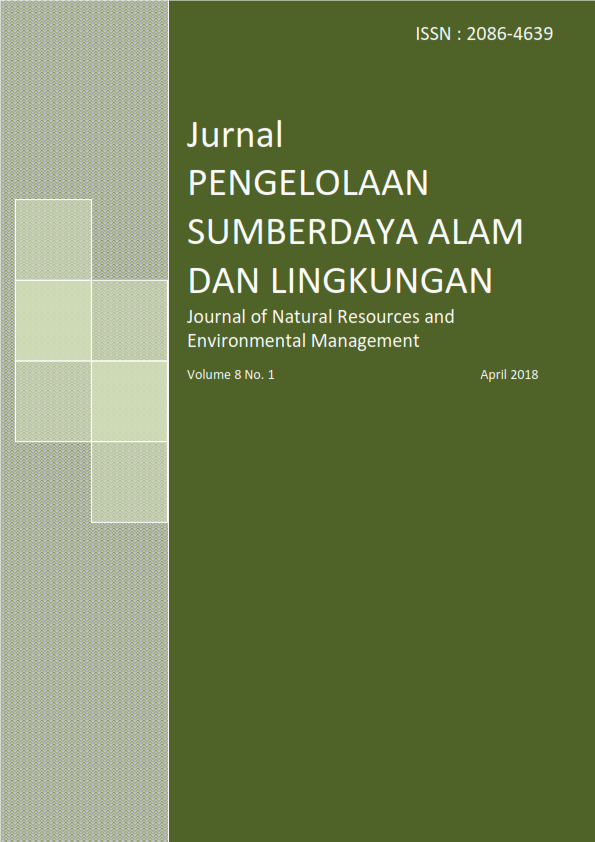PENERAPAN METODA FUZZY DALAM KLASIFIKASI LAHAN KRITIS BERBASIS HYDRAULIC RESPONSE UNIT (HRU) SUBDAS CISANGKUY
Abstract
Various natural disasters, such as floods and landslides, are often associated with extreme weather conditions, especially rainfall, where in fact the possibility of such a disaster will be smaller if the carrying capacity of the land is still good. The decrease of land carrying capacity is often due to land use change, so that the land is not capable to perform it functions and is categorized as critical land. The decline in land carrying capacity will affect other resources, especially water resources. Anticipatory measures of natural disasters such as floods and landslides can perfectly prepared if information regarding land conditions, including land criticality, are available in detail and up to date. The classification and mapping of land criticality becomes an important component in the preparation of land rehabilitation and natural disaster prevention plans including setting the priority actions. The Minister of Forestry Regulation no P.32 / Menhut-II / 2009 concerning Procedures for Preparation of Forest and Watershed Technical Rehabilitation Plan was use as criteria for land classification and both Fuzzy and Crisp calculation methods were applied to calculate the final score. Different classification result was found in 23 HURL and comparing to actual the condition, the Fuzzy method gives more accurate result than Crisp method.
References
Anik, S, 2007. Evaluasi Kekritisan Lahan Daerah Aliran Sungai. Jurnal Presipitasi. 2(1), pp. 8-14.
Baharuddin, 2010. Pemanfaatan Inderaja Dan Sistem Informasi Geografis (SIG) Dalam Inventarisasi Lahan Kritis Di Kabupaten Kolaka Utara. Jurnal Perenial. 6(2), pp. 83-89.
Hall, G.B., F. Wang, Subaryono, 1992. Comparison of Boolean and fuzzy classification methods in land suitability analysis by using geographical information systems, Environment and Planning A. 24, pp. 497-516.
Hasan M., A. Sapei, J. Purwanto, Sukardi, 2011, Kajian kebijakan pengelolaan sumber daya air pada daerah aliran sungai Citarum, Jurnal Sumber Daya Air. 7(2), pp. 105-118.
Kastaman R., D.R. Kendarto, S. Nugraha, 2007. Penggunaan Metode Fuzzy Dalam Penentuan Lahan Kritis Dengan Menggunakan Sistem Informasi Geografis di Daerah SUBDAS Cipeles. Jurnal Teknotan. 1(2), pp. 1-11.
Keshavarzi A., F. Sarmadian, A. Heidari, M. Omid, 2010. Land Suitability Evaluation Using Fuzzy Continuous Classification (A Case Study: Ziaran Region). Modern Applied Science. 4(7), pp. 72-81.
Kumar S., A. Mishra, 2015. Critical Erosion Area Identi-fication Base on Hydrological Response Unit Level for Effective Sedimentation Control in River Basin. Water Resource Management. 29(6), pp. 1749-1765.
Kusumadewi, S., H. Purnomo, 2010, Aplikasi Logika Fuzzy Untuk Pendukung Keputusan. Graha Ilmu, Yog-yakarta.
Purwaamijaya, I.M., I. Widianingsih, 2013. Aplikasi GIS Untuk Pengelolaan Das Berkelanjutan Di Sub DAS Ciwidey Kabupaten Bandung, Kolokium Pengelolaan Sumberdaya Ait 2013, Puslitbang Sumber Daya Air, Badan Penelitian Dan Pengembangan Kementerian Pekerjaan Umum, Bandung.
Prasetyo, S.Y.J., B.S. Hasiholan, Hartomo, P.K.D. Mila, B. Nuswantoro, 2013. Geographic Information System of Critical Level of Land Degradation (Critical Land) Based on Agro-ecological Zone (AEZ) in Agricultural Areas with Recombination Method of Fuzzy Logic and Scoring. International Journal of Computer Science Issues. 10(1), pp.
Baharuddin, 2010. Pemanfaatan Inderaja Dan Sistem Informasi Geografis (SIG) Dalam Inventarisasi Lahan Kritis Di Kabupaten Kolaka Utara. Jurnal Perenial. 6(2), pp. 83-89.
Hall, G.B., F. Wang, Subaryono, 1992. Comparison of Boolean and fuzzy classification methods in land suitability analysis by using geographical information systems, Environment and Planning A. 24, pp. 497-516.
Hasan M., A. Sapei, J. Purwanto, Sukardi, 2011, Kajian kebijakan pengelolaan sumber daya air pada daerah aliran sungai Citarum, Jurnal Sumber Daya Air. 7(2), pp. 105-118.
Kastaman R., D.R. Kendarto, S. Nugraha, 2007. Penggunaan Metode Fuzzy Dalam Penentuan Lahan Kritis Dengan Menggunakan Sistem Informasi Geografis di Daerah SUBDAS Cipeles. Jurnal Teknotan. 1(2), pp. 1-11.
Keshavarzi A., F. Sarmadian, A. Heidari, M. Omid, 2010. Land Suitability Evaluation Using Fuzzy Continuous Classification (A Case Study: Ziaran Region). Modern Applied Science. 4(7), pp. 72-81.
Kumar S., A. Mishra, 2015. Critical Erosion Area Identi-fication Base on Hydrological Response Unit Level for Effective Sedimentation Control in River Basin. Water Resource Management. 29(6), pp. 1749-1765.
Kusumadewi, S., H. Purnomo, 2010, Aplikasi Logika Fuzzy Untuk Pendukung Keputusan. Graha Ilmu, Yog-yakarta.
Purwaamijaya, I.M., I. Widianingsih, 2013. Aplikasi GIS Untuk Pengelolaan Das Berkelanjutan Di Sub DAS Ciwidey Kabupaten Bandung, Kolokium Pengelolaan Sumberdaya Ait 2013, Puslitbang Sumber Daya Air, Badan Penelitian Dan Pengembangan Kementerian Pekerjaan Umum, Bandung.
Prasetyo, S.Y.J., B.S. Hasiholan, Hartomo, P.K.D. Mila, B. Nuswantoro, 2013. Geographic Information System of Critical Level of Land Degradation (Critical Land) Based on Agro-ecological Zone (AEZ) in Agricultural Areas with Recombination Method of Fuzzy Logic and Scoring. International Journal of Computer Science Issues. 10(1), pp.
Authors
BudiantoB. S., Jarwadi PurwantoM. Y., WidiatmakaW. and PrasetyoL. B. (2018) “PENERAPAN METODA FUZZY DALAM KLASIFIKASI LAHAN KRITIS BERBASIS HYDRAULIC RESPONSE UNIT (HRU) SUBDAS CISANGKUY”, Jurnal Pengelolaan Sumberdaya Alam dan Lingkungan (Journal of Natural Resources and Environmental Management). Bogor, ID, 8(1), pp. 120-126. doi: 10.29244/jpsl.8.1.120-126.
Authors who publish with this journal agree to the following terms:
- Authors retain copyright and grant the journal right of first publication with the work simultaneously licensed under a Creative Commons Attribution License that allows others to share the work with an acknowledgement of the work's authorship and initial publication in this journal.
- Authors are able to enter into separate, additional contractual arrangements for the non-exclusive distribution of the journal's published version of the work (e.g., post it to an institutional repository or publish it in a book), with an acknowledgement of its initial publication in this journal.
- Authors are permitted and encouraged to post their work online (e.g., in institutional repositories or on their website) prior to and during the submission process, as it can lead to productive exchanges, as well as earlier and greater citation of published work (See The Effect of Open Access).





